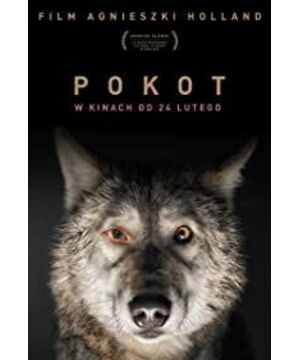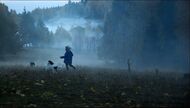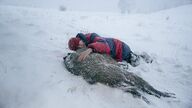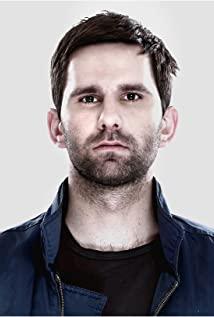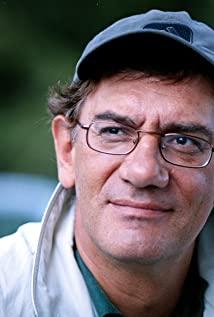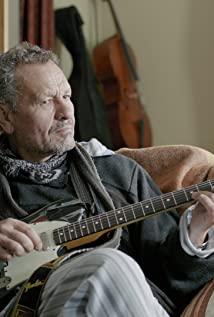1. Variation of the genre: the dark fairy tale of the suspense film "The Land of the Bone"
In beautiful fairy tales, there are often dark places hidden. Although the sun is shining, the shadows must be there. There is also a fairy tale about the night hunter in "The Land of the Bone". Hunters hunt animals, night hunters hunt people. The night hunter's dog turned into moss.
In fact, "Land of the Bone" itself is a dark fairy tale. In the quiet and clean mountains and forests, the sounds of wild beasts one after another highlighted the silence and harmony at this time. The original calm was broken by a group of poachers driving off-road vehicles and carrying shotguns. They gathered in a clearing in front of the mountain. The dazzling headlights and the warning sound of percussion suggested that the nightmare of the mountains and animals was coming. . The guardian of the animals - the night hunter, Dusjeko, she is a witch who understands astrology. Her energy comes from the sun. Every day at sunrise and sunset, she would open her arms wide and accept the baptism of the sun. Because the sun is fair to people and animals. However, too many people ignore animal rights. Dusjeko confronts poachers, police, and priests, and faces their indifference and will. Dusjeko "casts magic" and, with the "help" of animals, punishes insatiable poachers and hypocritical priests. Dusjeko's good friend Wilsky, "Good News" Novena, an entomologist, and a police station programmer helped her escape. In the end, they lived happily in a house in the forest.
The ending of the film is bright and beautiful, just like every fairy tale of princes and princesses. But the killings were real and detailed. Cruelly slaughtered deer, bloody animal skins, smashed human faces, corpses covered with blood beetles... In fact, in the last shot of the film, Dusjeko, who was running happily, and the disappearance of the two dogs It is already hinting at the passing of beautiful and pure.
The genre program of suspense films generally has equal rivals, such as the detective and the criminal in "Seven Deadly Sins". The two sides competed in terms of intelligence and physical strength, one round, two rounds, three rounds, until the righteous one beat the evil one with one punch after slowly accumulating strength.
The suspense at the beginning of the film is the disappearance of the two dogs of Dusjeko, followed by the death of the "bigfoot" neighbor, the sheriff who died in the snow, the disappearance of the poacher Naizak, and the mayor with blood beetles crawling inside and outside. , the priest who died in the church fire. This is a serial murder case where the common deceased is hunting animals or disregarding their rights. And Dusjeko's explanation for this is the movement of the celestial bodies, the fate of people and the killing of animals.
Then the type variation of "The Land of the Bone" is that the police and prosecutors who are on the side of solving the case seem to be synonymous with "incompetence". Although they can't believe Dusjieko's astrology and animal killing theory, they seem to be incompatible. Nothing works. It was her friend, a programmer who worked for the police station who saw Dusjeko's crime, and eventually fled with her. It can be seen that the tension of this suspenseful narrative is not between the detective and the criminal, but between animals and people. At the masquerade ball in August, Dusjeko, the big bad wolf, was one of the animals.
2. Light and Darkness: Flashbacks, Beams and Close-ups
Good and evil coexist, light and dark coexist, this is the law of nature.
There is no one who is absolutely kind. In order to protect animals, from panic at first, to familiarity later, and tears of crocodiles at the end, Dusjeko's serial killings also seem to have violated her original appeal of seeking equality between humans and animals. In the end, she handed the pheromone to the mayor out of personal desire (to save Novena from prison) and went to the extreme of fanaticism. In the process of killing the mayor, the composition of one of the shots only retained the part of the wolf's head that Dusjeke wore, symbolizing that she had completely transformed into an animal at this time, and her human nature was completely suppressed by the animal nature. The Bible says that if you have no sin, then you can stone the sinful person. The modus operandi of Dusjeko's killing of the sheriff and Nezak was to slam the head with a rock-hard ice block. At this time, we can think that Dusjeko's identity is a neutral judge, and she is an innocent person. And the development of the matter finally went out of control. Dusjeko has been blinded by hatred, and she is no longer innocent.
In fact, one of the main characteristics of the main characters of the film is that each of them is a flawed individual. Taking Dusjeko's astrology as a narrative opportunity, the characters' historical or traumatic experiences are explained through flashback editing. Such as the "good news" Novena and Naizak's underground relationship, the police station programmer witnessed his grandmother's body when he was a child, and Wilski witnessed his mother who committed suicide when he was a child. The unknown flaws and dark performances of each character make the characters more dimensional and more realistic. They are not saints. Like all people, they have the same desires, the same virtues, the same weaknesses, the same obsessions. Life is complicated, and so is human nature. In this way, we may be able to understand and tolerate them better.
In this regard, one of the major performances of the film's visual experience, I think, is conveyed through the beams of various light sources. The real darkness is not just about the darkness on the screen, but the actors actually stay in the darkness. This brings a certain level of realism. Many of these light sources are flashlights from characters, such as Dusjeko who sends the children to help find Yonka and Leah (two dogs) who are missing. In the forest, more than a dozen flashlight beams cut through the dark night with difficulty, and the flashlight light accidentally but inevitably illuminated the bloody brutality in the forest. A stagnant deer with wide, silent, innocent eyes, with mottled wounds and separated flesh. The consciences of the children and Dusjeko are like a tiny flashlight, briefly witnessing the truth in the dark, insensitive, insensitive night of the whole town. Wherever the beams of the headlights, flashlights, and hat-top lamps reach, it is dark night, but death.
Another noteworthy aspect of the film's visual experience is that during the confrontation between Dusjeko, the police and the priest, what seemed to be a close-up shot of the opponent's mouth and eyes that Dusjeko felt subjectively was suddenly inserted. Close-up of the mouth and eyes of the priest (representing faith, moral authority) and the policeman (representing legal authority), the mouth is open and closed, and the messy beard has become a symbol of preaching and admonition. And where this admonition comes from, it is not pure. The detached part and the effect of estrangement make the audience realize the ugliness of the other party at once.
Overall, the film is very informative and has a lot to interpret. From the point of view of feminist film criticism, the black screens at the beginning and end of the film are accompanied by female monologues, telling sentences of revelatory or allegorical significance – the eternal woman guides us forward. The film also tells the story of a woman (lack of female sexuality) who resists the slaughter of the shotgun (patriarchy) and cares for vulnerable creatures with fraternity.
View more about Spoor reviews


